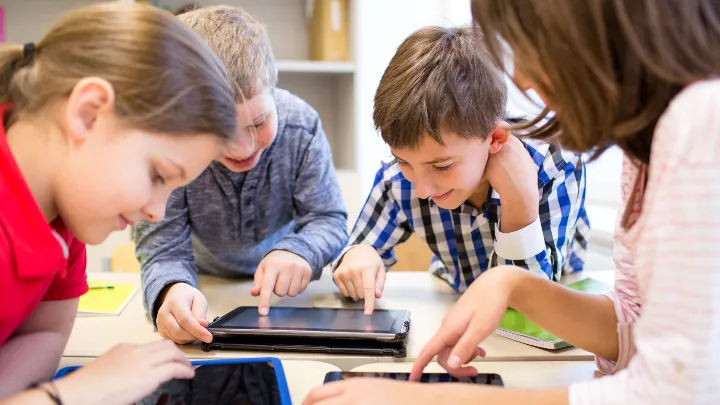
Learning and video games: make or break?

When you think of video games, several images may come to mind: an adult immersed in a game of FIFA, a teenager on a mission in the offbeat world of Minecraft, or a child venturing into the enchanted worlds of Super Mario Kart. Often relegated to the status of mere leisure pursuits, these games sometimes carry the label of a contested influence. But beyond these often outdated clichés lies a little-known educational potential.
While video games remain a tool for entertainment, they have developed enormously in recent years to become a key player in the field of education. Yes, learning from behind a console or tablet is becoming increasingly widespread. In schools, but also at home, children (as well as adults) can learn, grow and develop. 🧠
At Babaoo, we’ve developed an adventure game designed with kids in mind. Its aim? To teach them how their own Brain works, making learning and fun coexist. However, like any innovation, it presents as many opportunities as challenges. So what are the benefits of such an approach? And what could be its potential pitfalls?
The risks of video games
❌ Risk #1: the imbalance between screen and non-screen time 📺
Specialists agree on this crucial point: it’s essential to limit children’s screen time. Their developing brains struggle to distinguish the real from the virtual, plunging them into deep immersion inside a world that doesn’t exist.
Sure, two hours on Wikipedia may be more enriching than two hours on GTA, but screen time remains the same. Over the last 30 years, the amount of time children spend playing outdoors has only decreased. This trend, on the rise worldwide, seems to coincide with the rise of new technologies.
✏ Note: did you know? Today, in the UK, children spend on average half as much time outdoors as their parents at the same age. Even more worryingly, in the USA, children spend an average of less than 10 minutes a day outdoors, compared with over 7 hours in front of a screen… And technology has a lot to do with it.
If playing is beneficial, playing outside is even more so! Outdoors, your little adventurer can run, jump, climb… And moving around is good for your health! Not to mention the benefits of sunlight and its vitamin D content. And playing outside also means connecting with nature and discovering an environment conducive to imagination and creativity.
❌ Risk n°2: impact on sleep time
It’s advisable to keep children away from screens at least 2 hours before going to sleep. 🛏️
Sleep plays a crucial role in the development of our dear children. The more time they spend playing or scrolling, the more likely their bedtime routine is to be disrupted.
The cause: the light emitted by screens, also known as “blue light“, which interferes with the production of melatonin, the sleep hormone. It also plays a harmful role for eyesight, notably increasing the risk of myopia.
Sleep quality suffers, and disturbed sleep can lead to a host of health problems: increased risk of diabetes, weight gain, anxiety, stress and even attention deficit disorder !
❌ Risk No. 3: unsuitability of the game for the child
Before downloading or buying a game for your child, always check the minimum age requirement. ⛔ Video games are classified according to several age brackets, the famous PEGI 3, 7, 12, 16 and 18, whose purpose is to inform consumers about the types of content included. These pictograms, mandatory on all games sold in the European Union, are all too often overlooked at the time of purchase. We’re talking here about warnings against violence, nudity or the use of illegal substances…
If you’ve bought a game that doesn’t match your child’s age, you have two options: wait until he or she reaches the appropriate age or, if the age gap isn’t too wide and your child is mature enough, activate a parental control. Certain game features will then be blocked, such as chat or the online store… or how to avoid a nasty surprise on your credit card at the end of the month! 😅
✏ Note: online game chat, if unframed, can represent a danger to children. In addition to the verbal violence to which your child may be exposed, it’s also a haven for certain types of predator. As children rarely have access to social networks, they are sometimes contacted via chat rooms in their online games by people posing as other children. Fortunately, this real danger can be avoided by deactivating chat, or by regularly checking the contacts that the youngest maintain on the Internet.
The benefits of video games
✅ Benefit #1: building self-esteem
Whatever the game, on a screen, outdoors or on a board, winning a game triggers a release of dopamine, the happiness hormone. The player feels better, proud of himself and this boosts his self-esteem, and therefore, his self-confidence. 💪
Playing also helps to stimulate empathy. By slipping into the skin of their character, players forge bonds and learn to understand the emotions and feelings of others. These games can thus become valuable socialization tools, helping children to interact better with their classmates or even with you, as a parent.
✅ Benefit #2: increased speed of information processing
In the fast-paced, stimulating world of some video games, information flies at breakneck speed, demanding immediate reaction from players. 🕹️ Adventure games, puzzles or RPGs (Role Play Gaming, games like Pokemon or Final Fantasy, in which the main character evolves through quests), require the ability to respond quickly, a skill that proves invaluable in everyday life.
According to a 2016 Spanish study (Pujol et al., 2016), playing an hour a week of video games can increase children’s motor and cognitive abilities, enabling them to react more quickly to external stimuli.
Babaoo’Tip 💡
- Although children playing video games develop an ability to respond more quickly to stimuli (Pujol et al., 2016), research has not highlighted any significant improvement in Attention or Memory.
- In other words, the child reacts faster, but not necessarily more intelligently. What’s more, researchers have observed that the more time a child spends in front of a video game, the fiercer the conflicts he or she will face off-screen. It’s advisable to limit video gaming to less than 1 hour a day for children under 5 and less than 2 hours for those between 5 and 11.
✅ Benefit #3: development of comprehension and logic skills
Did you know that when children play, their cognitive functions are constantly engaged? 🧠 His brain is constantly and multidimensionally solicited, calling on his memory, logic, concentrationand coordination.
Some video games, like Babaoo, invite the player to take on challenges that stimulate different abilities. In our game, for example, we decided to focus on Precision, Coordination and the ability to say “Stop, I’ll think before I act” in the “Inhibition” section. To pass a level, or progress in Babaoo’s story, the player also mobilizes comprehension and logic skills: investigating a surprising phenomenon by questioning several characters, finding one’s bearings in space to head in the right direction, remembering information to solve puzzles, etc. 💡
These logical skills developed in play then find their application in everyday life, enriching the child’s approach to the challenges of his or her everyday life.
✅ Benefit no. 4: a less passive activity than television
Unfortunately, TV and console screens are often lumped together. Yet there’s “screen” and “screen”, and they don’t act on the brain in the same way. 🖥️
Television is an essentially passive medium. Apart from watching the images and, perhaps, responding to the solicitations of characters like Dora the Explorer, the child doesn’t play an active role in what’s being broadcast. By contrast, the experience is radically different with video games. Even if he remains seated, the child who plays is actively engaged. His brain is being called upon: he’s learning, developing and putting his cognitive abilities to work.

The Babaoo recap
So, for or against the use of video games in your loulous’ learning? At Babaoo, we believe that screens, adapted games and well-thought-out support can be a fun way for children to learn. 🎓 The magic recipe for good use lies in a skilful balance: avoiding excessive restriction while preventing abusive consumption.
One last piece of advice before we conclude: a video game is and must remain a game. 🎮 It should never occupy the major part of your child’s day. Be there to accompany him, let him know how much time he has left to play (you’d hate to have to close your book in the middle of a chapter, it’s the same in a video game) and discuss with him what he’s just experienced in his game. After all, sharing these experiences, too, enhances the pleasure of playing! 😄
You may also be interested in these articles


